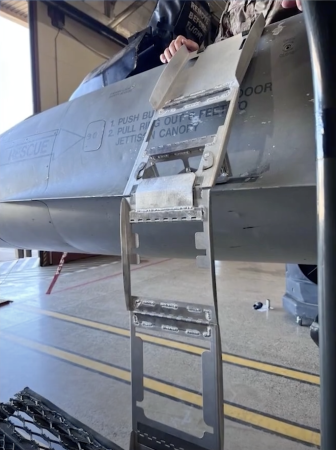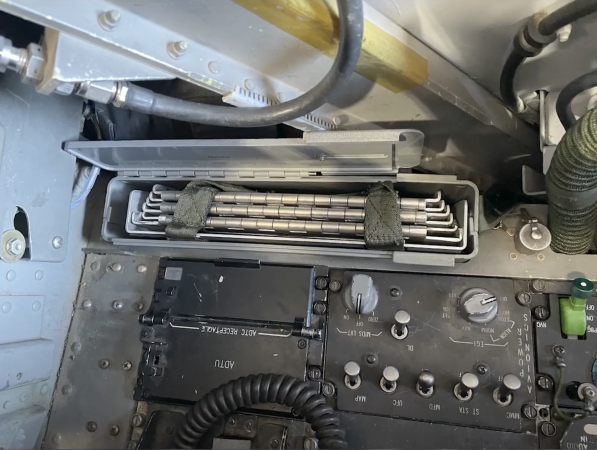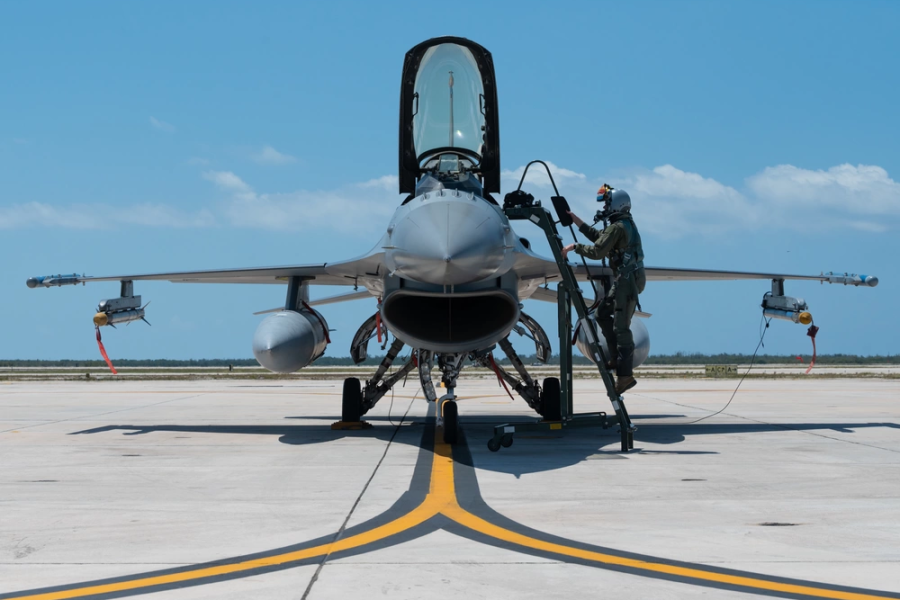While helping design the aircraft that would eventually become the F-15 and F-16 in the 1960s and 1970s, Col. John Boyd sought to cut as much weight as possible to make the aircraft more maneuverable and affordable. That meant no built-in ladders to carry into forward areas.
“Tell them to get some goddamn orange crates and climb on those,” Boyd said, according to a 2002 biography written by Robert Coram.
While the F-15 eventually got a built-in ladder, the F-16 did not, leaving pilots to rely on prepositioned ladders or awkwardly skitter along the aircraft’s fuselage before jumping down from the wing, not the most ideal or safe solution when pressed for time in a combat zone.
But one enterprising F-16 pilot has designed a lightweight ladder that Viper drivers can carry into battle without Boyd rolling over in his grave.
The F-16 cockpit collapsible Agile Combat Employment ladder weighs just six pounds and folds into the cockpit map case, which goes unused in an age where electronic tablets have largely replaced paper maps and publications.

The idea just took the top prize at Spark Tank, the annual contest where Airmen, Guardians, and their civilian counterparts submit ideas to improve the force.
The ladder project lead, Maj. Nicholas Atkins, an F-16 pilot with the 31st Fighter Wing at Aviano Air Base, Italy, said the ladder would help enable Agile Combat Employment, the concept where Airmen launch and recover aircraft from small, scattered airfields to minimize the chance of being targeted by long-range missiles.
Today’s bulky ladders take up precious space and weight on cargo aircraft tasked with moving troops, supplies, and equipment in and out of airfields as part of ACE, Atkins explained in a pitch video. Cutting that weight out of the logistics requirement for moving an F-16 squadron may not be the kind of maneuverability that Boyd envisioned, but it’s what Air Force officials say is needed to win a conflict with China or Russia.
“This enhances flexibility for the warfighter: from the fighter pilot in the seat, to the commander in the field, to the [Air Operations Center] controlling the war, enabling the agility required for great power competition,” Atkins said.

The Climb
Refining, mass-producing, and distributing the ladder across the Air Force will take effort. There are several dozen F-16 squadrons, and Atkins envisions 18 ladders per squadron, starting with those based in Europe and the Pacific.
“This would allow us to get ladders to the warfighters closest to the fight and most likely to immediately ACE first,” he said. “After this initial buy, we could continue to phase in Air Combat Command assets, thereby enhancing the capability for follow-on forces.”
Atkins has already set up an indefinite delivery/indefinite quantity contract with Bunker Supply, an equipment development and manufacturing firm, to design a new version of the ladder with input from the Air Force’s F-16 System Program Office. But more work is needed; in his pitch video to Spark Tank, Atkins said the project needs $548,000 to achieve interim prototype testing and refinement to make sure the design can be mass-produced and bought online by F-16 squadrons.
The ladder faced tough competition at Spark Tank. Other ideas included an app to help streamline mission prep and cargo configuration for transport loadmasters; an autonomous flightline resupply vehicle for aircraft maintainers; and a project to train and supply Air Force medics for performing whole blood transfusions in the field. The panel of judges included Vice Chief of Staff of the Air Force Gen. James C. “Jim” Slife, Vice Chief of Space Operations Gen. Michael A. Guetlein, and other top Air and Space Force officials and industry experts.
“What a tough set of decisions and just a remarkable opportunity today to be able to engage with our innovators in the Department of the Air Force,” Undersecretary of the Air Force Melissa Dalton said in a press release. “So inspirational. Please keep innovating, please keep leading yourselves and encouraging others to lead innovation.”
Winning Spark Tank does not guarantee funding, since not all finalists need or request funding, Air Force spokesperson Laurel Falls told Air & Space Forces Magazine. Instead, it helps connect finalists and semifinalists with top service officials, industry experts, and other innovation development groups, such as AFWERX, who can offer guidance.
Falls said other benefits include “opening doors for patent filings and partnerships with industry through AFWERX or the Program Offices and provides opportunities for the broader industry base to help us solve these challenges versus relying only on [original equipment manufacturer] vendors.”

What’s next for the ladder project? Falls said the team needs to update its statement of work (SOW) for their assigned contract support team, who will then help them get the ladder through prototyping and ready for online purchase. Atkins will also need to meet with various offices to nail down other kinds of support needed to scale up, and use of the ladder will have to be authorized via Technical Order updates.
“While Spark Tank helped secure initial resources and connections, fully executing the collapsible ladder project will require additional funding,” Falls said. “Nonetheless, both the visibility and credibility gained from Spark Tank have accelerated connections with Air Staff and functional decision-makers and that’s crucial for advancing the project.”
The spokesperson said the ladders are expected to be authorized and available for squadrons to purchase by fall 2025. The ladders are expected to cost a little less than $2,000 each.
Most other Air Force fighter jets have built-in ladders to use if more sturdy external ones are not available. The F-22 does not have one, though Hawaii Air National Guardsmen tested a prototype collapsible ladder at an exercise in 2023.

